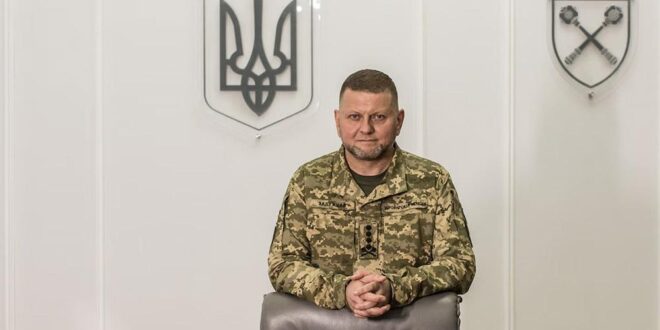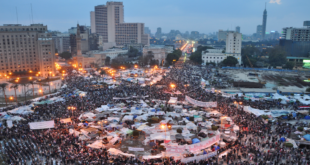The dispute is not over who has done more for victory, but over who is most to blame for the fact that the turning point in Ukraine’s favor never came.
As the war in Ukraine reaches the end of its second year, not a trace remains of the former unity among the Ukrainian elite. The longer the fighting drags on, the more tempting it is to look for someone to blame, and the more real the threat of internal destabilization. The most dangerous fault line is that between the civilian and military authorities, personified by President Volodymyr Zelensky and Commander in Chief of the Ukrainian Armed Forces Valery Zaluzhny.
General Zaluzhny took up his post in July 2021, at a time when tensions with Russia were growing and Zelensky was seeking to improve his poor standing in the military. Zelensky and his chief of staff Andriy Yermak chose Zaluzhny to replace his unpopular predecessor, Ruslan Khomchak—who was also in constant conflict with the Defense Ministry—because he was a good fit for the system overhaul taking place: he was young and had come up through the army ranks of an independent Ukraine, and advocated for the implementation of NATO military standards.
Zaluzhny immediately began working to strengthen Ukraine’s defenses and intensify military cooperation with NATO. The new commander in chief was not afraid to transfer the initiative to lower-level commanders, and gave permission to soldiers fighting in the Donbas combat zone to return fire without seeking authorization from the senior leadership.
The general also showed political talent that he tried not to advertise. He managed to establish contacts with paramilitary and nationalist circles that were distrustful of Zelensky. Zaluzhny held meetings with military bloggers and volunteers, and in December 2021 he appointed Dmitry Yarosh, the former leader of the ultranationalist Right Sector organization, his advisor.
Following Russia’s full-scale invasion of Ukraine, the popularity of both Zelensky and Zaluzhny skyrocketed. They became a symbol of the unity of the civilian and military authorities in saving the country. Zaluzhny is also popular in the West. Time magazine included him—along with Zelensky—in its list of the most influential people on the planet, while Politico said he would “enter Ukrainian military lore as a historic figure.”
This idyll did not last long, however. The first whispers of disagreements between the commander in chief and the president appeared in the spring–summer of 2022, once the Ukrainian capital was no longer under direct threat and the initiative at the front had passed to the Ukrainian side.
The first sign was a conflict over the establishment of Zaluzhny’s own charitable foundation, which was seen as an attempt to create the foundations for a political project. Then came a public dispute in July 2022, when the General Staff prohibited Ukrainians eligible for military service from changing their place of residence without permission from the military authorities. Zelensky slammed the move as “serfdom,” and ordered the military not to take such steps without his approval.
Efforts were made to halt the disagreements, but the outline of a potential rift was obvious. On one side, some in the military and political opposition were seeking to capitalize on the situation by contrasting the heroic military with the useless civilian authorities. On the other side, the presidential administration feared that as the fighting subsided, former frontline soldiers would want to see one of their own at the helm of the country—and Zaluzhny is the perfect candidate.
By the fall of 2023, when it was clear that the Ukrainian offensive had not lived up to expectations, rumors of disagreements between the military and civilian authorities intensified. Accumulated fatigue from the war, frustration over corruption, and uncertainty over the future were taking their toll. The dispute is not over who has done more for victory, but over who is most to blame for the fact that the turning point in Ukraine’s favor never came.
The detonator was publications by influential Western media, which are traditionally given great importance in Kyiv. On one side, Time magazine published an article describing the despondency reigning in Kyiv government offices, contrasting it with the messianism of Zelensky. On the other side, Zaluzhny gave an interview to the Economist in which he talked about the need to go on the defensive, arguing that the Ukrainian armed forces’ chances of turning the tide are practically zero. Zelensky publicly criticized his commander in chief’s position as overly pessimistic, and later hinted strongly that the military should not get involved in politics in wartime.
The presidential administration under Yermak has tried to blame the differences on the machinations of Russian agents. But they have become so obvious that they can no longer be explained by misinformation alone.
The Security Service of Ukraine (SBU) has opened an investigation into the surrender of southern Ukraine at the beginning of the Russian invasion, with Zaluzhny himself reportedly summoned as a witness. New Defense Minister Rustem Umerov has started to dismiss generals close to Zaluzhny, and the representative of the ruling party on the parliamentary defense committee, Maryana Bezuhla, went as far as to call for Zaluzhny’s resignation, prompting the president’s representative in parliament to step in to end the scandal.
Such contradictory signals are reminiscent of the discord of Zelensky’s first year in power, and indicate that Kyiv does not have a clear strategy for breaking the deadlock at the front. They also create a sense that the presidential administration is testing public reaction to various scenarios by floating them via different representatives of the presidential team.
David Arakhamia, head of the parliamentary faction of Zelensky’s Servant of the People party, for example, has said that, hypothetically, the outlines of a peace agreement could be put to a referendum, which would legitimize the idea of resuming negotiations with Moscow.
Zelensky himself is hostage to his image as a winner, and therefore continues to insist on nothing less than a return to Ukraine’s borders as they were in 1991, at the collapse of the Soviet Union: i.e., including Crimea (68 percent of Ukrainians say this is the only acceptable outcome of the war). Technically, therefore, the president has the backing of public opinion, which is not ready to compromise with the aggressor. But war fatigue is growing fast in Ukrainian society.
The domestic opposition is actively exploiting the differences between Zelensky and Zaluzhny. Parliamentary deputies from the European Solidarity party have spread rumors that Zaluzhny was about to be fired or prosecuted. Others have demanded that Zelensky form a government of “national unity” together with representatives of the opposition (like in Israel), while Roman Kostenko, a deputy from the Voice party, has claimed that favoritism encouraged by Zelensky has led to a split within the armed forces.
The opposition is clearly hoping to take advantage of the stalemate at the front and war fatigue in both Ukraine and the West to torpedo Zelensky’s ratings and put itself forward as an alternative. But Ukrainian society is still opposed to holding elections during wartime, and even if it does come to that, the majority of Ukrainians will most likely rally around the current president. They will certainly not back the old elites, including former president Petro Poroshenko, who dreams of revenge.
Nor is there any reason for Zelensky to enter into any kind of coalition with his opponents. The president still has a majority in parliament and full control of the government.
In this situation, Zaluzhny is the opposition’s main hope. In a hypothetical election, only a candidate from the armed forces could defeat Zelensky. According to recent opinion polls, Zaluzhny is already the second most popular public figure in the country, and the only one to have chances to rival Zelensky in hypothetical presidential elections if he decides to run.
Zaluzhny himself has not yet shown any political ambitions. He readily comments publicly on military topics, but skillfully avoids touching on politics, and compared with the hysteria of the civilian authorities and their political opponents, he exudes stoic calm. He appears to be quite satisfied with the existing balance, in which the president, while exercising general leadership, does not interfere in purely military affairs. The person violating this status quo right now appears to be Zelensky.
The inevitable involvement of the military in politics, which is growing every month, increases the risks of Ukraine’s internal destabilization. Zelensky is already talking about the threat of a third Maidan (as Kyiv’s previous two revolutions are known) allegedly being plotted by Moscow, though it is clear that discord among Ukrainians themselves poses a much greater threat. The specter of civil strife—like that which has repeatedly destroyed the foundations of Ukrainian statehood in the past—should give everyone concerned pause for thought. Ukrainian history, however, shows that that’s not always how it works out.
 Eurasia Press & News
Eurasia Press & News



